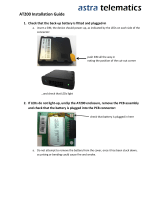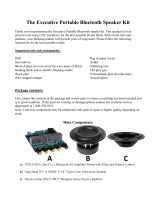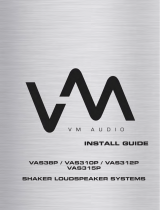-3-
WS-AT200
• This speaker system is a 2-way bass-reflex type
incorporating a 30-cm (12”) woofer and a Square
Contour Wave Guide (SCWG) horn tweeter.
• The speaker system accepts a continuous program
input of 300 W or 150 W (RMS). It delivers high out-
puts from its compact body with a maximum sound
pressure level of 121 dB.
• The SCWG horn minimizes the disturbing reflection
sound generated near the open end and to provide
a constant directivity of 90˚ (horizontal) and 40˚
(vertical). You can easily attach again the horn to
the enclosure by turning it 90˚ as required for hori-
zontal or vertical speaker installation.
• The enclosure has essential features such as
toughness to transportation, a recessed type han-
dle for carrying, the convex and concave for stack-
ing, holes for mounting bracket, safety wires, etc.
PREFACE
WS-AT250
• This Subwoofer is a bass-reflex type incorporating a
20-cm (12”) cone speaker and to be used with the
RAMSA Subwoofer Processor WS-SP2A.
• The WS-AT250 accepts an input of 400 W (RMS). It
delivers high outputs, though it is small in size, with
a maximum sound pressure level of 117 dB.
• The enclosure has essential features such as
toughness to transportation, a recessed type han-
dle for carrying, the convex and concave for stack-
ing, holes for mounting bracket, safety wires, etc.
PRECAUTIONS
* High frequency noise developed by fast-forward
or fast-rewind operation of a tapedeck
* Out of tune noise in FM broadcast
* Feed-back from microphones or electronics
musical instruments
• Match the polarities of all the speakers by observing
the connectors and wire colours when using two or
more speakers.
• Read “PROTECTION CIRCUITS” on page 8. Turn
down the volume control of the amplifier immediate-
ly if the sound suddenly decreases.
• You should use the WS-AT250 Subwoofer all the
time with Subwoofer Processor WS-SP2A. The WS-
SP2A processes the signal to protect the speakers
from damage due to an excessive input signal.
• Power loss may increase as the total speaker
impedance gets lower with a number of speaker
hookups. Use the largest speaker cable in wire
gauge to reduce power loss.
• Switch off the power amplifiers before connecting
the speakers or other peripherals.
• Avoid the followings all the time to protect the
speakers from damage.
* Turning on and off mixing consoles and other
peripherals may cause shock noise when the
amplifiers and subwoofer processor are on
* Shock noise resulting from the connection/ dis-
connection of inputs/outputs with any powered-
up equipment
* Pop noise from microphones without appropri-
ate use of breath-pop screen and/or high-pass
filter
* Click noise caused by switching on or off the
phantom power for microphones
* Continuous operation at very low frequency from
an oscillator, synthesizer or program sources.














